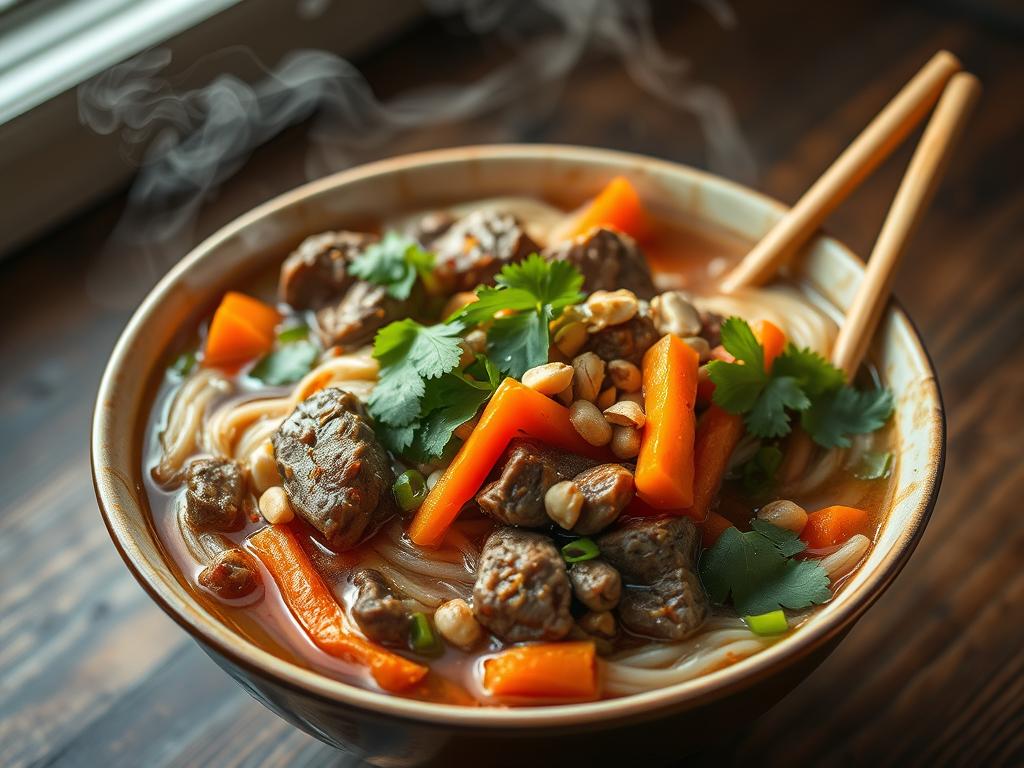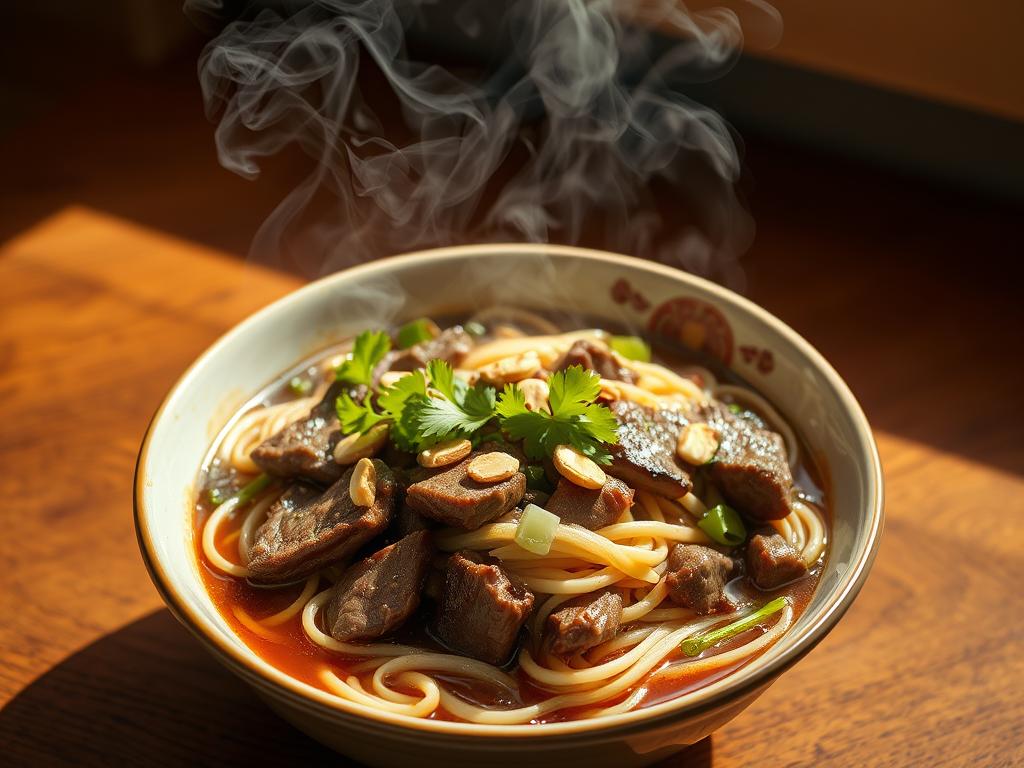Imagine savoring a dish that’s both flavorful and easy to prepare, with tender strips of beef and chewy rice noodles in a savory sauce. You can now enjoy this restaurant favorite in the comfort of your own home, in under 30 minutes.
Table of Contents
The secret to achieving that signature tender, velvety beef texture lies in a simple technique using bicarbonate of soda. This game-changing method allows you to recreate the soft, velvety texture of restaurant beef, making it a perfect option for home cooks.
This dish is not only delicious but also cost-effective and customizable with various vegetables and sauce options to suit your taste preferences.
Key Takeaways
- Easy to make at home in under 30 minutes
- Achieve tender, velvety beef with a simple technique
- Cost-effective meal option for a family of four
- Customizable with various vegetables and sauces
- Restaurant-quality taste without the restaurant price
The Appeal of Beef and Rice Noodles
With its rich flavor profile and straightforward preparation, beef and rice noodles have gained popularity worldwide. You can create a dish that’s not only delicious but also tailored to your preferences.
A Quick and Flavorful Dinner Solution
Beef and rice noodles offer a quick and flavorful dinner solution that can be prepared in no time. By mastering a few simple techniques, you can create authentic Asian flavors without needing specialized equipment. The balance of sweet, savory, and umami flavors in the sauce is a key element that elevates this dish, making it comparable to what you’d find in high-end restaurants.
Restaurant-Quality Dish at Home
The secret to achieving restaurant-quality beef lies in using bicarbonate of soda (baking soda) in the marinade, which tenderizes the meat and gives it a signature velvety texture. By making beef and rice noodles at home, you can customize spice levels and ingredients to suit your taste. Additionally, homemade versions allow you to avoid excess oil, salt, and MSG often found in restaurant versions. This not only makes the dish healthier but also opens the door to exploring other Asian-inspired recipes.
Essential Ingredients for Perfect Beef and Rice Noodles
Crafting an authentic beef and rice noodle experience requires attention to the essential ingredients. The quality and combination of these components will elevate your dish from a simple meal to a culinary delight.
Selecting the Right Cut of Beef
Choosing the right cut of beef is crucial for achieving tender and flavorful results. Opt for cuts that are known for their tenderness, such as sirloin or ribeye. Slicing the beef thinly against the grain will also enhance the texture.
Rice Noodles: Types and Preparation
Rice noodles are a staple in this dish, and understanding their types and preparation methods is vital. You can choose between thin, delicate noodles or thicker, chewier ones, depending on your preference. To prepare, simply soak the noodles in hot water until they are soft and pliable.
Key Sauce Components
The sauce is a critical element that brings the dish together. The stir-fry sauce typically includes a combination of dark soy sauce, oyster sauce, light soy sauce, and sesame oil. Soy sauce provides depth, while garlic adds a pungent flavor. Sugar balances the saltiness and creates a glossy finish on the beef.
- The difference between light and dark soy sauce lies in their fermentation time and salt content, with dark soy sauce contributing a richer, more complex flavor.
- Shao Xing wine, or Chinese rice wine, enhances the flavor and can be substituted with dry sherry or mirin if needed.
- Adjusting the sauce components allows you to tailor the flavor to your taste preferences while maintaining an authentic taste.
Preparing Your Beef for Stir-Frying
Preparing your beef for stir-frying is a crucial step that can make or break your dish. The way you slice and prepare your beef directly impacts its tenderness and flavor.
The Secret to Tender, Velvety Beef
To achieve tender, velvety beef, it’s essential to slice it against the grain. This technique shortens the muscle fibers, making the beef more tender and easier to chew. Using a very sharp knife is crucial for making clean, precise cuts that won’t tear the meat. For even better results, consider partially freezing the beef for 15-20 minutes before slicing. This will firm up the beef, making it easier to achieve ultra-thin cuts.
- Slicing against the grain to ensure tenderness
- Partially freezing the beef for easier slicing
- Using a sharp knife for precise cuts
Slicing Techniques for Best Results
When slicing your steak, identify the direction of the grain first. The grain refers to the lines or fibers you see on the surface of the meat. Slicing against these lines is key to tender beef. Thin, uniform slices not only cook more evenly but also develop a more flavorful crust when stir-fried. Properly sliced beef will cook in just 2-3 minutes, preserving its juiciness and preventing it from becoming tough.
Step-by-Step Beef and Rice Noodles Recipe
Making beef and rice noodles at home is easier than you think with this step-by-step guide. This recipe breaks down the process into manageable steps, ensuring that you can create a delicious and satisfying meal with minimal effort.
Marinating the Beef
The first step in preparing your beef and rice noodles is to marinate the beef. This process involves mixing the beef with a blend of sauces and spices to enhance its flavor and tenderness. To marinate the beef, combine it with your chosen marinade ingredients in a bowl, ensuring that the beef is fully coated. Let it sit for at least 30 minutes to allow the flavors to penetrate the meat.
Cooking the Rice Noodles
Cooking the rice noodles is a straightforward process. Simply soak the noodles in hot water until they are tender, then drain and set them aside. The key is to not overcook the noodles, as they can become mushy and unappetizing.
Stir-Frying Process
The stir-frying process is where the dish comes together. Start by heating a pan over high heat and adding a small amount of oil. Then, add the marinated beef and cook until it’s browned and cooked through. Next, add beef juices that have accumulated on the plate to the pan to maximize flavor.
Toss the noodles into the pan along with the dark soy sauce, oyster sauce, and light soy sauce. Use tongs to combine the ingredients, ensuring that the noodles are evenly coated with the sauce. Add the bean sprouts and cook for a further minute, or until the beef is warmed through.
- Combine cooked beef, prepared noodles, and sauce components in the proper order.
- Toss ingredients gently to ensure even sauce distribution without breaking the noodles.
- Add any accumulated beef juices back to the pan for maximum flavor.
Bringing Everything Together
Once all the ingredients are combined, turn off the heat and drizzle with sesame oil. This final touch adds a rich, aromatic flavor to the dish without overpowering the other ingredients. Serve the beef and rice noodles immediately, as the texture and flavor are best appreciated when the dish is fresh.
By following these steps, you can create a delicious beef and rice noodle dish that’s sure to satisfy your cravings. Enjoy your meal!
Pro Tips for Restaurant-Quality Results
Creating an authentic, restaurant-quality beef and rice noodle dish at home requires attention to detail and the right cooking methods. To achieve this, you’ll need to master a few key techniques that will elevate your dish from good to great.
High Heat Cooking Techniques
Cooking with high heat is crucial for achieving that signature stir-fry flavor and texture. When you cook your beef and vegetables over high heat, it allows for a quick sear that locks in juices and flavors. This technique is essential for creating a dish that’s both tender and flavorful.
Use a hot wok or large skillet and make sure it’s heated properly before adding your ingredients. You can test the heat by flicking a few drops of water onto the surface; if they sizzle and evaporate quickly, it’s ready for cooking.
Preventing Noodles from Breaking
Rice noodles can be delicate, so it’s essential to handle them with care to prevent breakage. Soak them in hot water until they’re tender but still retain some firmness. Avoid overcooking, as this can make them brittle and prone to breaking.
Balancing Flavors in Your Sauce
The key to a great stir-fry sauce lies in balancing its components. A typical sauce includes dark soy sauce, oyster sauce, light soy sauce, and sesame oil. The harmony of sweet, salty, sour, and umami flavors is fundamental to Asian cooking.
| Sauce Component | Role | Potential Substitution |
|---|---|---|
| Dark Soy Sauce | Adds color and depth | Mushroom soy sauce or regular soy sauce with molasses |
| Light Soy Sauce | Provides saltiness | Regular soy sauce or tamari |
| Oyster Sauce | Umami flavor | Hoisin sauce or a mixture of soy sauce and sugar |
| Sesame Oil | Aromatic flavor | No direct substitution, use sparingly |
To achieve the perfect flavor profile, taste and adjust the sauce components according to your preference. Remember that a teaspoon of sesame oil can go a long way due to its strong aroma. If the sauce needs thickening, a cornstarch slurry can be used.
Customizing Your Beef and Rice Noodles
One of the best things about beef and rice noodles is how easily you can make it your own. This dish is a canvas waiting for your personal touch, whether you’re looking to add some extra nutrition, change up the flavor, or adjust the spice level.
Adding Vegetables for Extra Nutrition
You can enhance the nutritional value of your beef and rice noodles by incorporating a variety of vegetables. Consider adding bell peppers, carrots, or snap peas to increase the vitamin and fiber content. Simply stir-fry these vegetables along with the beef and noodles for a balanced meal.
Sauce Variations and Substitutions
The sauce is a crucial component that can be modified to suit your taste preferences. You can experiment with different ingredients like hoisin sauce, oyster sauce, or soy sauce to create a unique flavor profile. For a creamier sauce, try adding a tablespoon of peanut butter or coconut cream.
Making It Spicy or Mild
For those who enjoy a little heat, you can add chili garlic paste or red chili pepper flakes to increase the dish’s spice level. To adjust the heat, you can use various ingredients such as fresh chilies, chili oil, or Sriracha. Adding spice during different stages of cooking can achieve different effects – for deep heat, add it during the marinade, and for a bright, fresh heat, add it towards the end. Even for those who don’t typically enjoy spicy food, a small amount can enhance the overall flavor. Here are some guidelines for different heat levels:
¼ teaspoon for mild, 1 teaspoon for medium, and 1 tablespoon for hot.
| Heat Level | Measurement | Ingredient |
|---|---|---|
| Mild | ¼ teaspoon | Chili flakes |
| Medium | 1 teaspoon | Sriracha |
| Hot | 1 tablespoon | Chili garlic paste |

Serving Suggestions and Pairings
Elevate your dining experience with these ideas for serving and pairing beef and rice noodles. The right accompaniments can enhance the flavors and textures of this dish, creating a well-rounded meal.
Garnishes That Elevate the Dish
Adding a garnish can make a significant difference in the presentation and flavor of your beef and rice noodles. Consider using fresh herbs like cilantro or basil, or add some toasted sesame seeds for a nutty flavor. A squeeze of fresh lime juice can also add brightness to the dish.
- Fresh herbs like cilantro or basil
- Toasted sesame seeds
- Lime wedges
Complementary Side Dishes
While beef and rice noodles are satisfying on their own, pairing them with complementary side dishes can enhance the meal. Opt for light and refreshing options like a simple cucumber salad or a bowl of miso soup. Steamed edamame or pickled vegetables can also provide a nice contrast in texture and flavor.
If you’re looking for other recipe ideas to serve alongside beef and rice noodles, you might enjoy: Ginger Chicken Noodles, Filipino Stir-fried Noodles & Chicken, or Red Curry Coconut Noodles. These dishes offer a variety of flavors and can add to the diversity of your meal.
Storing and Reheating Leftovers
To enjoy your beef and rice noodles later, proper storage is key. You should store leftovers in an airtight container to maintain freshness. Place the container in the refrigerator within two hours of cooking to prevent bacterial growth.
Your leftover beef and rice noodles can be safely stored for up to 3 days. When you’re ready to eat them, reheat the noodles in a pan over heat, adding a bit of water or soy sauce if they’ve dried out. This method helps restore their original texture.
It’s worth noting that freezing is not recommended as it can negatively affect the texture of the rice noodles. Before refrigerating, make sure to set aside any portion you won’t be eating immediately. Always reheat your leftovers thoroughly to ensure food safety.

Conclusion
Bringing the flavors of your favorite restaurant dish into your own kitchen is simpler than you think. With the techniques outlined, you can now enjoy beef and rice noodles that rival those served at your favorite eateries.
By mastering the simple steps and tips provided, such as tenderizing beef with baking soda and cooking rice noodles to perfection, you’re set aside to experiment with various recipes and make this dish your own. With a little time and practice, beef and rice noodles can become a staple in your culinary repertoire.
We encourage you to share your experiences and any questions you may have about this recipe, and to explore the world of delicious Asian-inspired dishes that await you.
FAQ
What type of beef is best suited for stir-frying in a beef and rice noodle dish?
How do you prevent rice noodles from becoming mushy or breaking during cooking?
Can you customize the sauce in a beef and rice noodle recipe to suit your taste preferences?
What are some recommended vegetables to add to your beef and rice noodle dish for extra nutrition?
How should you store leftovers of beef and rice noodles to maintain their freshness?
What are some tips for achieving a restaurant-quality beef and rice noodle dish at home?
Explore More:
The Best Recipe For Tex-Mex Enchiladas 2025
Delicious Small Batch Pancakes for Any Occasion
Can You Use Pancake Mix for Waffles?
Chili Recipes Featuring Enchilada Sauce 2025
Ho Fun Noodles: A Savory Asian Delight

